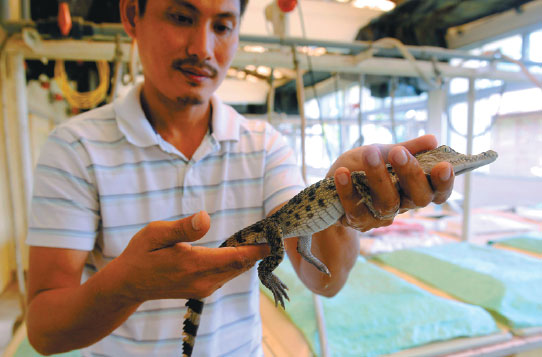Rare crocodiles survive in Philippine 'Noah's Ark'
A chorus of chirps filled the room as one of the Philippines' top crocodile breeders checked on his wards in an overcrowded "Noah's Ark" for one of the world's most endangered animals.
The chicklike cries came from metal tanks holding the baby Philippine crocodiles, artificially hatched by incubators from eggs that Glenn Rebong and his team had poached from their mothers' nests.
"We're producing so many, but there are few opportunities to release them in the wild. So they get stuck here and you get overcrowding,"Rebong told AFP at the 2-hectare Palawan Wildlife Rescue and Conservation Center.
|
Crocodile breeder Glenn Rebong holds a weeks-old freshwater crocodile, one of the world's rarest animals, artificially hatched in incubators from eggs at a crocodile farm in Puerto Princesa, Palawan island. Ted Aljibe / Agence France-Presse |
Crocodylus mindorensis once lived in large numbers in freshwater lakes and rivers across the Southeast Asian archipelago, and they are endemic to the Philippines, but were decimated by illegal hunting for the fashion industry.
Fearful humans who mistake the timid creatures for their man-eating saltwater cousins and kill them, as well as the animals' loss of habitat, have also contributed to their demise.
By the time the Philippine government launched its captive breeding program in 1987, a survey found only about 250 were estimated to be in the wild.
Today there are likely fewer than that, as the areas they have been seen in recent years have got steadily smaller, Rebong said.
The International Union of Conservation and Nature lists them as "critically endangered", which is one step away from extinct in the wild.
The largest collection of the species now lives at the center, while two smaller private breeding operations elsewhere in the Philippines and some small sanctuaries in the wild are also key to the crocodiles' survival.
Built with Japanese development aid, the now financially struggling center in the southwestern city of Puerto Princesa is home to about 500 crocodiles, about half of them freshwater and the rest "salties".
The center augments a meager government budget by putting some of the baby and adult crocs on display for tourists, who are warned not to stick their hands or feet into the enclosures.
The freshwater species was hunted close to extinction even though the rougher skin on its flanks is inferior to those of Crocodylus porosus, the larger saltwater crocodiles that are a mainstay of the fashion industry.
Growing to not more than 3 meters, the freshwater crocodiles are shy animals that eat smaller prey than their bigger cousins.
Unlike large crocodiles, which defend territory, they tend to slink away from humans, and Rebong said there was no record of any member of the species ever killing a person.
Dangers in wild
However, few Filipinos make the distinction between the aggressive salties and the freshwater crocodiles, killing either if seen.
This has been a big factor in so few having been released into the wild, as has been their relentlessly diminishing natural habitats.
Freshwater swamps that are their favored homes are rapidly being converted into farms, housing, or ponds for commercial fish culture.
In the nature parks where they have been released, the government has had to run education and incentive programs to try to ensure they are not hunted down out of fear or for their lucrative skins.
"You can't simply release them anywhere. We have to make sure they are secure in a particular area. Otherwise, they could end up getting killed," Rebong said.
(China Daily 08/16/2014 page10)















